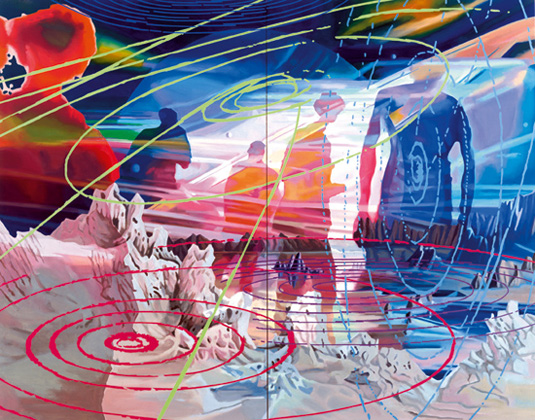| Corinne Wasmuht |
|
Andreas Beitin Corinne Wasmuht. (Non-)Places of the Real
Corinne Wasmuht thinks that the viewer often feels overwhelmed at first by the plethora of visual information in her pictures. Appearances deceive however for the opposite impression arises after a time, that of peace and quiet, since her pictures are shaped not by a chaotic profusion, but rather by an organized visual structure. The resources of Wasmuht’s large-format pictures, which are all painted in oils on wood, lie in an extensive visual archive: she has been collecting images from journals and magazines since 1986. The archive began with images of treetops, was supplemented by images of water and oceans, sand and deserts, and was finally ordered according to content and formal categories and stored in ring binders. In this way the painter has continually developed new, ramifying themes and sub-themes, so that gradually an extensive network of the most diverse topoi has arisen, from which Wasmuht recruits the models for her visual subjects, collages them, transfers them to canvas and so zooms from picture to picture: “I’m very critical about my pictures. Otherwise I’d never develop”. [1] Thus Wasmuht, who grew up in Peru and Buenos Aires, appropriates the world and attempts visually to get a hold of at least parts of it through her personal system of order. If for a period of about twenty years she first cut out, ordered and archived images from print media, she has, since the beginning of the present decade, focused increasingly on images drawn from the much-invoked flood of the Internet, which can not only be stored on a hard disk, but also printed out and archived. (The archive has since been exhibited by the Civic Art Associations of Hamburg and Aachen.) These multiple images, detached from their original context, are carried by their collage-like arrangements into a new context of meaning where they receive an unusual, baffling and sometimes disturbing valence. Not least thanks to this technique, Wasmuht’s paintings have proven to be “a contemporary way of treating technical and medial overkill”. [2] She simultaneously destroys visual worlds and builds new visual cosmoses; she cuts up and dismembers visual systems so as to let new ones arise. The cultural theorist Boris Groys has noted that “Most pictures in modernity have been produced by means of iconoclasm”; “whether symbolically or actually”, they have been “dissected, cut up, fragmented, penetrated and pierced”. [3] Wasmuht has long left this artistic method behind her, for she generates the new out of the destruction of models and heals, as it were, the previous destruction with her painting. If an almost two-dimensional visual composition still arrested her pictures from the 1980s and 1990s on the surface, her latest work opens spatial depths whose illusionist construction is characterized by a nearly breath-taking dynamics and energy, so that one could almost speak of an immersive style of painting. The pictures in the collection of the Landesbank Baden-Wuerttemberg illustrate in the most vivid way the development of this artist, who could be called “headstrong” in the best sense of the word. [...] [1] Corinne Wasmuht in conversation with the author, January 19, 2009. [2] Carmela Thiele, “Corinne Wasmuht. Aus Sand ein Seil flechten”, in: Kritisches Lexikon der Gegenwartskunst, Heft Nr. 7, Ausgabe 85, Zeit Kunstverlag, Munich, 2009. [3] Boris Groys, “Der Kurator als Ikonoklast”, in: Peter Weibel (ed.), Boris Groys. Die Kunst des Denkens, Philo Fine Arts, Hamburg, 2008, p. 96. Catalog excerpt "Extended. Sammlung Landesbank Baden-Württemberg" Editors: Lutz Casper, Gregor Jansen, published by Kehrer Verlag Heidelberg, 2009 ^
|

